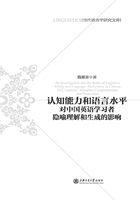
2.3.1 Introduction to cognitive linguistics
Cognitive linguistics is defined as“an approach to language that is based on our experience of the world and the way we perceive and conceptualize it”(Ungerer & Schmid 2001:F36).Philosophically, cognitive linguistics rests on experientialism as its theoretical foundation.Experientialism emphasizes the role of human body in the formation of concepts, and one of its central notions is embodiment, which means that thought and understanding are characterized in terms of our having our particular kind of bodies (Rakova 2004:19).A basic assumption of the philosophy is that language is closely related to human experience; that human experience with the world, to a great extent, determines language structure and meaning(Wang & Li 2004:1).Based on this assumption, cognitive linguists believe that knowledge grows out of human experience of the world and, in turn, “our shared experience of the world is also stored in our everyday language and can thus be gleaned from the way we express our ideas”(Ungerer & Schmid 2003:F38); and meaning is characterized in terms of embodiment, that is, in terms of our collective biological capacities and our physical and social experiences as beings functioning in our environment.Human bodily experience is assigned a central role in meaning, understanding, and reasoning(Yu 1998:22).What is worth noting here is that experience should not be understood here as only physical experience with the world.Other human experience such as the nature of our bodies, our genetically inherited capacities, our modes of physical functioning in the world, our social organizations, etc., are also included(Lan 2003:28).
Cognitive linguistics is a branch of linguistics that approaches language from the perspective of cognition.Therefore, to study metaphor in cognitive linguistics, we have to first of all explicate what cognition is and its relationship to metaphor.